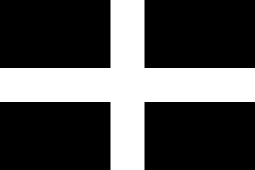St Ives School
The St Ives School refers to a group of artists living and working in the Cornish town of St Ives.[1]
History
The town became a magnet for artists following the extension to West Cornwall of the Great Western Railway in 1877. In 1920 Bernard Leach and Shoji Hamada set up a pottery in St Ives, creating the town's first international 20th-century art connection.
In 1928 Ben Nicholson and Christopher Wood visited St Ives where they were impressed by the work of local artist Alfred Wallis. This started the development of the Cornish fishing port as an artists' colony.
The St Ives School of Painting was established in the historic Porthmeor studios at the centre of St Ives' artists' quarter in 1938.
With the outbreak of World War II in 1939, Ben Nicholson and his then wife the sculptor Barbara Hepworth settled in St Ives, establishing an outpost for the abstract avant-garde movement in West Cornwall. They were soon joined by the prominent Russian Constructivist sculptor Naum Gabo.
After the war ended, a new and younger generation of artists emerged, led by Hepworth and Nicholson (Gabo departed in 1946). From about 1950 a group of younger artists gathered in St Ives who included Peter Lanyon, John Wells, Roger Hilton, Bryan Wynter, Patrick Heron, Terry Frost, Alexander Mackenzie, Harry Ousey, Wilhelmina Barns-Graham, Stass Paraskos, Paul Feiler, and Karl Weschke together with the pioneer modern potter, Bernard Leach (Nicholson departed in 1958). It is with this group, together with Hepworth and Nicholson, that the term 'St Ives School' is particularly associated.
A 2010 ninety-minute BBC 4 film, "The Art of Cornwall," presented by James Fox[2][3] explored in some detail the lives and works of many of the key figures and the contributions they made in establishing St. Ives as a major centre of British art from the 1920s onwards. Helen Hoyle's review of this programme[4] is also very informative.
St Ives School today
The heyday of the St Ives School was in the 1950s and 1960s but in 1993, Tate St Ives, a purpose-built new gallery overlooking Porthmeor Beach was opened which exhibits the Tate collection of St Ives School art.
In 2010 a new chapter for the School and the Porthmeor Studios began with the start of renovations headed by The Borlase Smart John Wells Trust, supported using public funding by Arts Council England. Desperately in need of attention, over the years the historic building had suffered from the harsh conditions of its marine environment.
While recent renovations have repaired and refurbished the Porthmeor Studios and ensured their future, the building’s character and charm remain unspoiled.
Seventy-five years after its conception, the School now occupies a unique position and continues to provide a creative and imaginative space where students can expand their knowledge and develop their skills.
The varied course programme attracts students from far and wide, to be taught by practicing artists in historic surroundings, at the centre of a thriving arts community. It offers regular drop in life drawing sessions, short courses and family activities, suitable for everyone from the complete beginner to the professional artist.
In addition to its popular art courses (taught by practicing artists), the School regularly holds various art events, including exhibitions and lectures, many of which occur during the St Ives September Festival.[5]
See also
- List of St Ives artists
- Barbara Hepworth Museum
- Paisnel Gallery
- Penwith Gallery
- Penwith Society of Arts
- Tate St Ives
References
- ↑ Tate St Ives, St Ives School, Tate Gallery.
- ↑ The Art of Cornwall, BBC.
- ↑ The Art of Cornwall-00 introduction, YouTube.
- ↑ Helen Hoyle, review of The Art of Cornwall, artcornwall.org.
- ↑ "Our History". schoolofpainting.co.uk. UK: St Ives School of Painting. Retrieved 2 September 2016.
External links
- Walker, John. (1992) "St Ives School". Glossary of Art, Architecture & Design since 1945, 3rd. ed.
- St Ives School of Painting website
